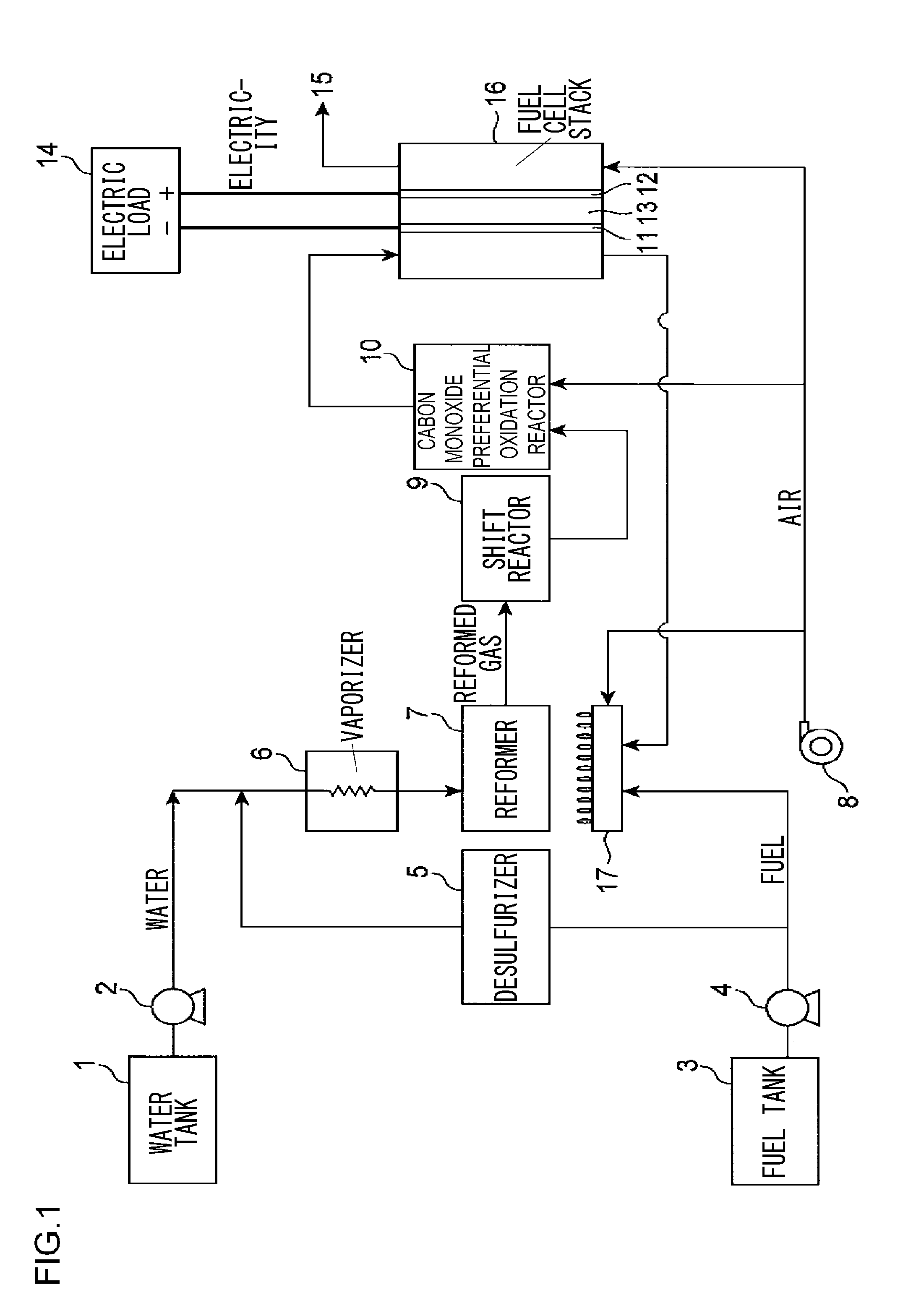Precursor of desulfurizing agent for hydrocarbon and manufacturing method thereof, calcined precursor of desulfurizing agent for hydrocarbon and manufacturing method thereof, desulfurizing agent for hydrocarbon and manufacturing method thereof, hydrocarbon desulfurization method, and fuel cell system
a technology of desulfurizing agent and hydrocarbon, which is applied in the direction of sustainable manufacturing/processing, physical/chemical process catalysts, other chemical processes, etc., can solve the problems of reducing the efficiency of the fuel cell accordingly, unable to employ the conventional desulfurizing process with hydrodesulfurization catalyst, and unable to achieve the effect of desulfurizing performance constant, remarkably improved endurance time, and effective removal
- Summary
- Abstract
- Description
- Claims
- Application Information
AI Technical Summary
Benefits of technology
Problems solved by technology
Method used
Image
Examples
first embodiment
[0050]A description is now given of a desulfurizing agent for a hydrocarbon according to a first embodiment (hereinafter, sometimes referred to as a “desulfurizing agent according to the first embodiment”). In the subject application, a desulfurizing agent for a hydrocarbon means a desulfurizing agent that has at least one function from among a function of absorbing sulfur compounds contained in the hydrocarbon, a catalytic function of converting the sulfur compounds to be more easily absorbed, and a function of absorbing the converted sulfur compounds.
[0051]The amount of porous inorganic oxide contained in the desulfurizing agent according to the first embodiment is 10 to 30 percent by mass, preferably 15 to 30 percent by mass, based on the total mass of the desulfurizing agent. When the amount contained is less than 10 percent by mass, the specific surface area of the desulfurizing agent decreases, and desulfurizing performance and endurance time during which the desulfurizing per...
second embodiment
[0103]A description is now given of a precursor of a desulfurizing agent for a hydrocarbon according to a second embodiment (hereinafter, sometimes referred to as a “desulfurizing agent precursor according to the second embodiment”). The desulfurizing agent precursor in the subject application yields a desulfurizing agent for a hydrocarbon through a calcination treatment and / or a reduction treatment. The precursor of the desulfurizing agent for a hydrocarbon according to the second embodiment contains: (A) porous inorganic oxide; (B) nickel atoms; and (C) carbon atoms. A detailed description is now given of each of the configurations in the following.
[0104](A) Porous Inorganic Oxide
[0105]The amount of porous inorganic oxide contained in the desulfurizing agent precursor according to the second embodiment is 10 to 30 percent by mass, preferably 15 to 30 percent by mass, based on the total mass of the desulfurizing agent precursor. When the amount contained is less than 10 percent by ...
exemplary embodiment 1-1
Manufacturing of Desulfurizing Agent Precursor
[0158]In an ion-exchanged water, 43.7 g of nickel nitrate hexahydrate (commercially available agent special grade) and 5.30 g of zinc nitrate hexahydrate (commercially available agent special grade) were dissolved to prepare 150 ml of an aqueous solution. The aqueous solution is referred to as liquid A. To an ion-exchanged water, 24.0 g of sodium carbonate (commercially available agent special grade) was dissolved and mixed with 20.6 g of commercially available silica sol (the particle diameter is about 7 nm, and the silica content is 3.30 g) to prepare 300 ml of a solution. The solution is referred to as liquid B. Liquid B was stirred at a temperature maintained to be 80 degrees Celsius, and liquid A was dropped in liquid B to form precipitate. After the dropping was finished, the heating and the stirring were continued for two hours so as to complete the generation of the precipitate. Then, the precipitate was washed with an ion-exchan...
PUM
| Property | Measurement | Unit |
|---|---|---|
| temperature | aaaaa | aaaaa |
| mole ratio | aaaaa | aaaaa |
| temperature | aaaaa | aaaaa |
Abstract
Description
Claims
Application Information
 Login to View More
Login to View More - R&D
- Intellectual Property
- Life Sciences
- Materials
- Tech Scout
- Unparalleled Data Quality
- Higher Quality Content
- 60% Fewer Hallucinations
Browse by: Latest US Patents, China's latest patents, Technical Efficacy Thesaurus, Application Domain, Technology Topic, Popular Technical Reports.
© 2025 PatSnap. All rights reserved.Legal|Privacy policy|Modern Slavery Act Transparency Statement|Sitemap|About US| Contact US: help@patsnap.com

